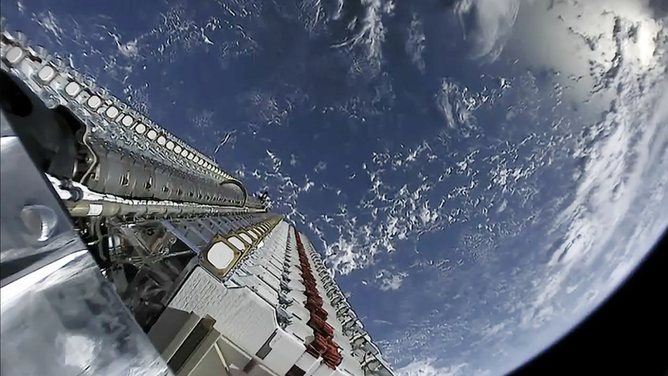Starlink satellites 'unintended' electromagnetic radiation could impact radio astronomy observations
The authors focused on SpaceX because it has the largest satellite constellation, but they expect to find similar unintended emissions from other low-Earth orbital satellites.
Starlink 'dishy' providing internet to Antarctica climate research base
The Center for Oldest Ice Exploration in Allan Hills, Antarctica shared this video of 30 knot (34.5 mph) winds, saying despite the cold and wind Starlink internet continues to work for the base that is searching for the oldest ice on Earth. (Video credit: Center for Coldest Ice Exploration/NSF/Oregon State University)
Astronomers have expressed concern about satellite constellations, like SpaceX's Starlink, made up of thousands of spacecraft, interfering with observations of the night sky.
When Elon Musk's company first started launching Starlink satellites by the dozen into low-Earth orbit, SpaceX took note of the concerns about light reflection interfering with astronomy observations and made some changes to the spacecraft design.
A new study released last week in the Astronomy & Astrophysics journal found that unintentional low-frequency radio waves can be detected by radio telescopes.
Scientists from several research institutions used the Low Frequency Array, or LOFAR, which includes dozens of arrays in the Netherlands and other European countries, to observe 68 Starlink satellites.
The study authors said they detected "unintended electromagnetic radiation" emanating from onboard electronics. Previously, astronomers were concerned about communications transmissions interfering, but the authors say this is a new problem.
"This study represents the latest effort to better understand satellite constellations’ impact on radio astronomy," the study's lead author Federico Di Vruno said in a statement. "Previous workshops on Dark and Quiet Skies theorized about this radiation, and our observations confirm it is measurable."

Artist’s impression of a large satellite constellation in low Earth orbit circling above the LOFAR telescope. (Credit: Daniëlle Futselaar)
(FOX Weather)
This is a problem for radio astronomy observations because the unintended tradition could impact astronomical research. Astronomers use radio observatories to listen for very faint signals in the universe, which requires having the telescope be away from human radio signals. Often, radio observatories are in remote areas, but satellites fly above the telescopes no matter where they are radiating signals at any time.
Astronomers are asking satellite operators to consider this new impact on radio astronomy as they develop new spacecraft.
STARLINK INTERNET 'DISHY' FACES OFF AGAINST SNOW, WILDFIRES IN REMOTE CANADA
SpaceX's Starlink constellation recently surpassed 4,000 satellites in orbit, according to Jonathan McDowell, an astronomer tracking large constellations and human-made objects in space.
"With LOFAR, we detected radiation between 110 and 188 MHz from 47 out of the 68 satellites that were observed. This frequency range includes a protected band between 150.05 and 153 MHz specifically allocated to radio astronomy by the International Telecommunications Union (ITU)," said study co-author Cees Bassa, from the Netherlands Institute for Radio Astronomy.

Starlink SpaceX during deployment.
(SpaceX / FOX Weather)
The authors said they focused on SpaceX because it has the largest constellation, but they expect to find similar unintended emissions from other low-Earth orbital satellites.
There are other large constellations in orbit and planned for the coming years, including OneWeb and Amazon's Kuiper Project.
"Our simulations show that the larger the constellation, the more important this effect becomes as the radiation from all the satellites adds up. This makes us worried not only about the existing constellations but even more about the planned ones – and also about the absence of clear regulation that protects the radio astronomy bands from unintended radiation," said co-author Benjamin Winkel, with the Max Planck Institute for Radio Astronomy in Germany.
The study authors are part of the International Astronomical Union's Centre for the Protection of the Dark and Quiet Sky from Satellite Interference and are in contact with SpaceX about their findings.
According to the authors, SpaceX offered to talk about ways to mitigate radio interference. Astronomers said they hope others in the space industry also take note.
